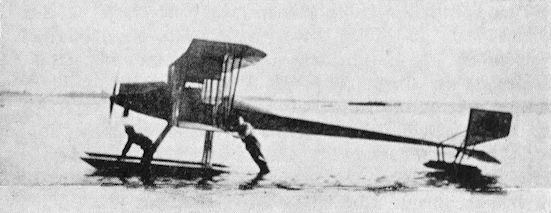В.Шавров История конструкций самолетов в СССР до 1938 г.
Самолет С-5а, гидроаэроплан двухпоплавковый был построен в конце 1912 г. по заказу морского ведомства под двигатель "Гном" в 60 л. с. По типу и схеме аппарат был близок к самолету С-6А, но с трехстоечной, уменьшенной на один пролет коробкой крыльев с двумя безреданными поплавками и с третьим поплавком - цилиндром под хвостом. Ширина фюзеляжа к хвосту уменьшалась незначительно, но высота сходила почти до нуля. Однако благодаря фанерной конструкции фюзеляж обладал в общем достаточной жесткостью, хотя и меньшей, чем фюзеляжи обычных габаритов. Самолет испытывался в Гребном Порту в Петербурге. Летал на нем Г. В. Алехнович. Мощность двигателя оказалась недостаточной, самолет не был принят морским ведомством и остался на заводе в качестве учебного.
Самолет "С-5а", гидроаэроплан однопоплавковый. Этот самолет, о котором сохранилось очень мало сведений, представлял собой второй вариант самолета С-5а на однопоплавковом шасси с подкрыльными поплавками и хвостовым цилиндром. Главный поплавок имел те же обводы, что и два поплавка, но удвоенной ширины. Двигатель - "Гном" мощностью 80 л. с. Самолет летал лучше, чем "Кертис" и "Фарман-XVI, был принят морским ведомством в качестве разведчика и отправлен в Ревель в сентябре 1914 г.
Самолет||С-5а двухпоплавковый
Год выпуска||1912
Количество двигателей||1
Двигатель, марка||
мощность, л. с.||60
Число мест||2
Длина самолета, м||8
Размах крыла, м||12,0/8,5
Площадь крыла, м2||30
Продолжительность полета, ч||4
Показать полностью
H.Nowarra, G.Duval Russian Civil and Military Aircraft 1884-1969
Meanwhile, Sikorski had not been idle, and in 1911 he built the S.5 biplane in two versions, landplane and seaplane. The fuselages of these were long and streamlined, a characteristic of designs from this source. The seaplane, fitted with twin floats, had its fuselage extended even further to offset instability caused by the floats and although no record remains of its performance, it may be noted as the first example of a Russian marine aeroplane. The S.5 landplane had a speed of 66 m.p.h. and a ceiling of 1,500 ft. Both machines were powered by the 50 h.p. Argus.
Показать полностью
A.Durkota, T.Darcey, V.Kulikov The Imperial Russian Air Service (Flying Machines)
Igor Ivanovich Sikorsky
The Imperial Russian Navy
During mid-summer 1912, Sikorsky's activities at the R-BVZ attracted the attention of senior Russian naval authorities, who were investigating the use of aircraft in the reconnaissance role. Upon their request, and with the approval of the R-BVZ, Igor Sikorsky served in the capacity of an engineer with the Russian Navy's Aviation Section, Combined Services, Baltic Fleet.
The air reconnaissance service was given the general assignment of off-shore sea observation within defined areas. But when moving from theory to practice, the Imperial Russian Navy came across problems as yet unsolved. The navy's largest problem was to obtain airplanes which met operational requirements. Due to the need for extended flights over water with extremely unreliable engines, airplanes which could take-off and land on water were needed.
Sikorsky felt he could design a floatplane which would meet the navy's needs, but due to his workload preparing for the First Russian Military International Aircraft Competition held in 1912, his early navy prototypes seem to have been non-innovative variants of his earlier landplanes.
Sikorsky S-5A Twin-Float Seaplane
Although the S-5A was completed in December 1912 (after the S-8), its initial construction had been started with the S-6B in mid-summer. As a result, the S-5A was a close copy of the Sikorsky S-6A landplane, but with a slightly smaller wing. The plane was fitted with two main floats and a small tail "cylinder" float. The fuselage width remained constant throughout its length, but its depth reduced greatly at the tail, which resulted in a very fragile appearance. In reality the plywood-covered (and wire-braced) fuselage actually resulted in a far more durable structure than was first thought. The aircraft was flight-tested by Gleb V. Alechnovich (a R-BVZ test pilot), in the harbor of St. Petersburg. Badly under-powered by its 60hp Gnome engine, the S-5A was not accepted by the navy and remained as a trainer at the R-BVZ factory. It is presumed this machine was converted to a landplane configuration and probably scrapped by the end of 1913.
Sikorsky S-5A Single-Float Seaplane
Built just after the twin-float version, this modified S-5A utilized a single main float of the same design as the two float version. However, its single float was twice as wide to provide the displacement achieved by the multi-float scheme. The small tail "cylinder" float remained and wing-tip floats were also fitted. Power was provided by a 80hp Gnome engine, which helped the aircraft fly better than the Russian navy's Curtiss and Farman floatplanes then in use.
The wings of the S-5A (single float) floatplane were of unequal length, with ailerons on the upper wing only. Constructed of wood and fabric covered, both wings were rectangular, with slightly rounded tips. Anti-skid vertical fins were located on each side of the fuselage and were connected to the wing's wooden struts. The tail surfaces were of light steel tubing covered with fabric. Rudder and elevator controls were of the normal cable-pulley type.
This machine was accepted by the Imperial Navy's Baltic Fleet sometime in early 1913, and put into service at Revel Air Station as a reconnaissance machine in September 1914.
Sikorsky Aircraft Data
Model: S-6B S-7 S-8 S-9 S-5A (twin float) S-5A (single float) S-10 (competition)
Year: 1912 1912 1912 1913 1912 1912 1913
Engine(s) type: 100hp Argus 70hp Gnome 50hp Gnome 100hp Gnome(1) 60hp Gnome 80hp Gnome 80hp Gnome
Length, m: 8.5 8.2 7.5 - 8 8 8
Wing Span, m: top/bottom 14.9/10.9 10 12/8 12 12/8.5 12/8.5 16.9/12
Wing Area, m2: 37.5 20 27 30 30 30 46
Wt. empty, kg: 590 449 - 690 - - 567
Wt. load, kg: 327 327 - 300 - - 444
Wt. flying, kg: 917 776 - 990 - - 1011
Wingload, kg/m2: 10.4 10.8 13 12.9 - - 22
Powerload, kg/hp: 16 10.2 8.9 7.2 - - 12.7
Speed, km/h: - - - - - - 99
Notes:
1. Gnome Monosoupape.
Показать полностью









